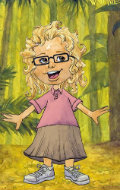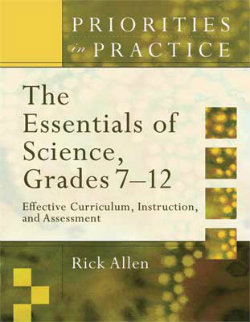A Guide to Science Curriculum, Instruction & Assessment
The Essentials of Science, Grades 7-12: Effective Curriculum, Instruction and Assessment
By Rick Allen
(ASCD, 2007 –Learn more)
 Reviewed by Deborah Gaff
Reviewed by Deborah Gaff
Reflective teaching is the process of examining what you do in the classroom and developing a plan to implement changes to improve teaching and learning. In the science classroom, reflective teaching is imperative as we strive to develop students’ interest and understanding of science in an increasingly competitive, globalized world.
 Although this ASCD reference was published in 2007, Rick Allen has put together a timeless collection of solid instructional research for the science classroom. It does not matter whether your curriculum is aligned to your state standards or the new Next Generation Science Standards, this book is a must read for the reflective educator.
Although this ASCD reference was published in 2007, Rick Allen has put together a timeless collection of solid instructional research for the science classroom. It does not matter whether your curriculum is aligned to your state standards or the new Next Generation Science Standards, this book is a must read for the reflective educator.
Allen combines examples of classroom practices and current research about science education from a variety of sources. He expertly develops the goals listed on the back cover of the book:
- How to make use of research within the cognitive sciences to foster critical thinking and deeper understanding.
- How to use backward design to bring greater coherence to the curriculum.
- Innovative, engaging ideas for implementing scientific inquiry in the classroom.
- Holistic strategies to address the complex problems of the achievement gap, equity, and resources in the science classroom.
- Strategies for dealing with both day-to-day and NCLB assessments.
- How professional learning communities and mentoring can help teachers reexamine and improve their practice.
As I read The Essentials of Science, Grades 7-12, I found myself applying Allen’s research to reflect on the unit I had just taught as well as the one I was preparing to teach.
Trends in Secondary Science Education
Chapter 1 focuses on current trends. Faced with standards driven accountability, educators are focused on measuring the amount of content taught, and it is easy to fall into the trap of “telling” students about science. Allen refocuses our attention on authentic inquiry and developing student mastery of the big ideas in science. As a visual learner, I appreciated The Inquiry Wheel Graphic depicting how practicing scientists explain their work. The graphic expands the scientific process we often see in our textbooks. The following stages are graphically displayed around the central hub labeled Questions: (1) Observing, (2) Defining the problem, (3) Forming the question, (4) Investigating the unknown, (5) Articulating the expectation, (6) Carrying out the study, (7) Interpreting the results, (8) Reflecting on the findings, and (9) Communicating the findings to the scientific community and society.
Planning a Curriculum of Essentials
Chapter 2 reminded me of an oft-heard admonition: if you fail to plan, you plan to fail. Backward design, a curriculum approach championed by Grant Wiggins and Jay McTighe, is introduced. The three-step design process challenges educators to first identify desired results, then define what constitutes evidence of success and finally determine what learning experiences and instructional methods will lead to achieving the desired results. Allen also highlights a Pennsylvania school district’s use of lesson studies among science teachers. Lesson studies are a highly reflective critical friend’s review of lessons that educators can use to fine-tune their instruction within a unit.
Bringing the Curriculum to Life in the Classroom
In chapter 3, Allen presents new research confirming that well written, standard-based curriculum — that is also rich in lab work and hands-on opportunities for students — can be successful in improving teaching and learning when implemented with fidelity. Success also requires educators who are comfortable with and knowledgeable about the content. We are reminded that trained educators who engage in reflective teaching, professional development and quality learning communities are a critical factor in student success.
Fresh Approaches to Teaching Urban and Minority Students
Allen introduces several strategies for building bridges and developing an understanding of the diverse cultural needs of students. A process called co-generative dialogue is a strategy where students and educators engage in discussions about the classroom experience and figure out ways to improve their combined experience. To better serve English language learners in the science classroom, Allen introduces a high quality, research based instruction using a method call SIOP (Sheltered Instruction Observation Protocol). The SIOP method emphasizes high-quality, hands-on experiences as the best way to introduce science concepts and terms to ELL students. As a middle school educator, I find that many of my general education students have limited exposure to science and science vocabulary. The SIOP method would be an excellent strategy for these general education students as well.
Assessment for Learning
This chapter has a great section on formative assessments. When instruction begins with the end in mind, a variety of formative assessments can be used to monitor student progress towards the goal. Allen cites research that using written feedback alone helps students focus on improving their work and not their letter grade. Using science notebooks where students are engaged in developing the assessment rubric helps build their understanding of the end goal as well.
Implications for Professional Development
A deep understanding of content and the nature of science can help teachers engage their students. Allen uses teacher observations to help the reader understand the importance of helping and mentoring new teachers in the development of engaging lessons and efficiently organized lab work.
As I look at my copy of this book, I see thoughts on sticky notes, underlined passages and highlighted main ideas. Ongoing professional development is essential for all science teachers whether they collaborate with science professionals, pursue additional degrees or participate in professional learning communities with their peers.
This book will not collect dust. Teaching and learning is a process that requires continuous improvement fueled by reflective practitioners. Allen’s book is a great reference to use when preparing to teach a new unit or reflecting on a lesson recently taught.
Deborah Gaff is a second career educator. She is currently the chief learner in middle school science and Project Lead the Way classrooms at Greensburg Junior High School in Greensburg, IN. Her teaching experience includes elementary, middle and high school classes. When not teaching she tinkers with computer programming, her first career. She tweets @debgaff.

































